
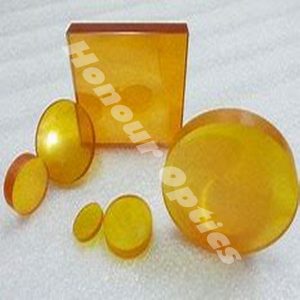
Zinc Selenide is relatively soft compared with other optical materials. Consequently, great care should be made in handling and cleaning the lenses. Incorrect cleaning can lead to surface damage that in turn will reduce the component lifetime. Surface contamination can be considered in three broad classes:
1. Contamination from the laser process, i.e. burned-in particles of back-spatter.
2. Dust, grease, and contamination by air-borne particles.
3. Human/biological stains caused by talking, coughing or sneezing near the exposed surfaces.
Cleaning Notes and Methods
1, Solvents
The cleaning kit cannot be supplied with solvents. Those solvents you actually need will depend on the nature of the contamination. For CO2 laser optics useful solvents have generally found to be, acetone, alcohol, hexane, distilled water, dilute white vinegar with a few % acidities.
The purpose of using a solvent is to dissolve the contamination so as to produce a solution that is easily soaked up. Rubbing the contamination to dislodge it without dissolving is not the ideal answer since the solid particles are more likely to scratch the surface. Therefore, identifying a suitable solvent for the contamination present is an ideal situation. It is often a trial and error process because the contamination itself is usually not known. The list of solvents above is a good starting point for CO2 laser optics and coatings.
2, Preparation
It is recommended that optics be removed from their mounts prior to the cleaning procedures where possible. This is particularly true if the whole optic requires cleaning. If the lens is part of a multi-element optical assembly, then it is not a good idea to remove it; to re-assemble may involve some alignment or calibration procedure the user is not familiar with.
If the optic can be removed from its mount make a note of which way round it is orientated. Also, remember that it is a good idea to clean the mount itself; if the lens is dirty, the chances are that the mount is also dirty. Dust and dirt will quickly find its way back onto the lens and any pieces of grit may prevent the proper seating of the lens and in turn, will cause uneven clamping and stress.Also, remember that it is a good idea to clean the mount itself; if the lens is dirty, the chances are that the mount is also dirty. Dust and dirt will quickly find its way back onto the lens and any pieces of grit may prevent the proper seating of the lens and in turn, will cause uneven clamping and stress.
Firstly, use the gloves provided to handle the optics. Work over a clean, clutter-free surface. Put several lens tissues on the surface in order to lay the lens on them. Never lay a lens or mirror with a convex face downward on a hard surface. The very small contact area and correspondingly high pressure will mark the surface. If you need to rest the lens with convex side down use a soft cloth folded several times to support the lens.
3, Remove Dust with the Rubber Blower
Hold the lens by its edge and with the surface vertical while using the rubber blower. Do not let the nozzle touch the surface. If the lens is still mounted, it may be an advantage to use the blower on the surface facing downwards. Any dust blown from the surface will then drop away.
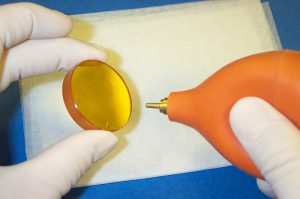
4, Using Q-tips to Remove Contamination
Wet the cotton tip with solvent. Gently wipe the surface with the cotton tip but do not scrub. Repeat as necessary using fresh Q-tips and to finally remove any solvent marks.
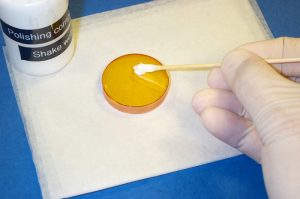
Use this method with any of the solvents or water/vinegar but finish with a clean Q-tip using acetone.
or use the following alternative method …
5, Using Lens Tissues with the Drag Method
This is a useful method to clean the whole surface but can require a bit of practice to get it correct. Also, this method may not work very well if the lens surface is too steeply curved.Also, this method may not work very well if the lens surface is too steeply curved.
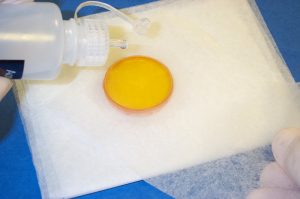
Lay a lens tissue across the surface of the optic. From the dispensing bottle, squeeze out enough acetone to wet the tissue over the complete surface. Carefully drag the tissue across the surface. With some practice of dragging at the right speed, the acetone and dirt are pulled with the tissue to leave a dry, streak-free surface behind.
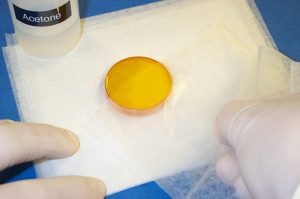
Use only with acetone, alcohol and other solvents.
6, Using Q-tips with Polishing Compound
This is the last resort method! It should only be used when all the other techniques fail with all solvents.a last resort method! It should only be used when all the other techniques fail with all solvents.
The bottle contains a very fine polishing compound mixed with distilled water. Shake the bottle before use, holding down the cap to prevent leakage.
Squeeze some drops onto the cotton tip and then very gently wipe the contaminated area. Applying much pressure will scratch the lens surface and remove the coating. If this starts to happen, stop immediately.
Do not let the compound dry on the surface. Add some drops of water if it does.
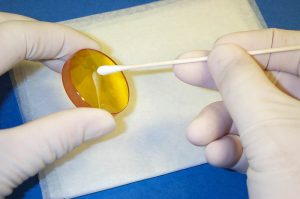
If the lens is unmounted, then to remove the polishing compound, first hold the optic vertically and squirt some distilled water over the surface and allow it to run off. This will wash away much of the compound. Use clean Q-tips with water to remove the rest. Finally, clean with acetone.
If the lens is mounted, you can only use Q-tips to wipe up the polishing compound. Finally, clean with acetone.
Give the lens an inspection. If the contamination is still present or the surface is damaged, you should consider replacing the lens.
7) Clean the Lens Edge
If your lens is unmounted, give the edge a wipe using a lens tissue and solvent.
8) Clean the Mount
Before re-installing the lens, use a lens tissue and solvent to wipe the lens mount, including threads, seals, etc. This is also a good time to clean other associated pieces of equipment, such as gas nozzles.